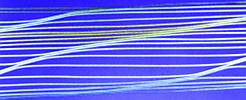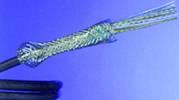
Today's leading edge serial interconnect standards exert some very demanding requirements on a copper link's ability to deliver usable output waveforms while jumping the hurdles of jitter, ISI, attenuation, reflections and crosstalk. As signal integrity hurdles get higher and higher, faster rise times mean more errors, system latency and shorter cables.
Managing the skew budget
In the past, circuit designers used to have the luxury of copper cable links with fat skew budgets. But today's faster speeds mean less time for everything that has to occur between clocking events. That means that cable skew - once virtually ignored by designers - has become a critical factor in skew budgets. The less time that can be budgeted to cable means more time available for set-up, hold, ISI and jitter. The trick is overcoming two major types of cable skew.
* Delay skew is created when multiple signals are transmitted simultaneously, but arrive at the cable ends at different times. Cables made with pairs, such as twisted or parallel, have two kinds of delay skew - within-pair and pair-to-pair.
Within-pair (or wire-to-wire) skew reduces system noise immunity and causes rise time degradation of the signal. In addition, a high within-pair skew will produce uncancelled currents travelling on the pair shield, creating EMI, crosstalk and further degrading the signal to the point of possible system failure. If within-pair skew can be reduced, so can accompanying EMI and crosstalk.
Pair-to-pair skew is the difference between fastest and slowest pairs in the cable. Its control becomes critical when a link uses a separate clock line (eg channel link) which must be synchronised accurately in relation to the data lines in order to correctly sample the data. Serial links have clocks embedded with the data stream and thus do not have tight restrictions on pair-to-pair skew.
* Amplitude skew (imbalance) occurs when two equal but opposite signals are transmitted into a pair, but unequal amplitude results on either leg at the receiver, due to attenuation effects on the leg. The longer the cable, the more problems will be encountered with sampling accuracy.

Amphenol has developed a new concept in individually shielded differential pair cabling for use in high data rate applications. Called Skewclear, this cabling features a manufacturing process that effectively corrects the causes of cable skew that creep into cables in the first place. The design consists of individually shielded multiple parallel pairs (Figure 1) which are laminated in a planar configuration to assure equal pair lengths. The flat cable pairs are bonded and then slit in a staggered fashion (Figure 2), enabling the cable to be flexibly cabled into a round format (Figure 3), yet keeping the same pair-to-pair physical length of a flat cable construction. Standard impedances are 100, 110, 120 and 150 Ohm.

As a result of this unique manufacturing approach, skew values can be consistently reduced to within 6,6 ps/m within-pair and 32,8 ps/m pair-to-pair, depending on pair count and dielectrics. Compared with industry-standard twisted-pair construction, this is a 200 to 400% improvement in skew control.
Other cable technologies, if manufactured with extreme care, often can yield very good skew performance. Skewclear, by design, makes tight skew control consistent, repeatable and easy.

Key features
* 31-32 AWG flat and round construction.
* 1-50 pair counts.
* Rugged polyolefin resists deformation, crushing and electrical variations.
* Parallel pairs eliminate twist length variation and resulting dielectric deformation.
* Unique laminated parallel sections preserve identical electrical length from wire-to-wire and pair-to-pair.
* Unique staggered slit between pairs enables cable to be formed into flexible round format with pair-to-pair uniformity of flat cable.
* Parallel pairs provide easy fixturing and mass stripping for labour savings.
* Optional plenum and zero halogen construction.
* Double overall shielding for maximum EMI/RFI protection.
* CL2/FT4 listed.
Connector compatibility
Skewclear can be terminated readily to all industry-standard I/O connectors, including MicroGiga CN, HSDC2, SCSI, VHDCI, D sub, 2 mm, MDR, LFH and METRAL. Also, parallel pairs by nature are easier to strip, since no untwisting of wire is involved in the process, unlike twisted and quad constructions.

© Technews Publishing (Pty) Ltd | All Rights Reserved